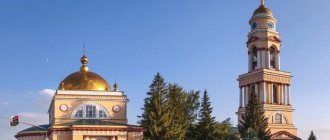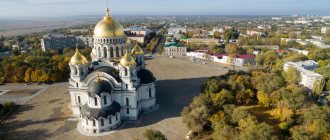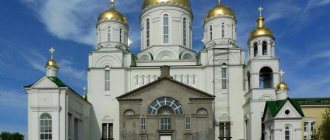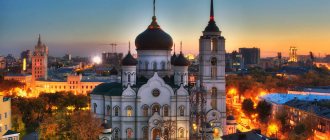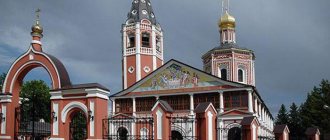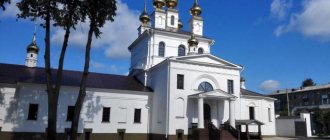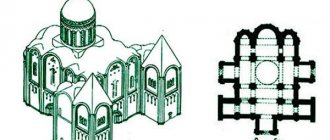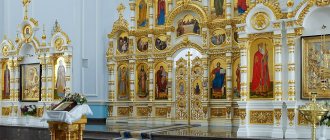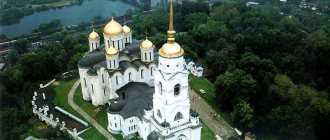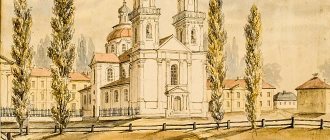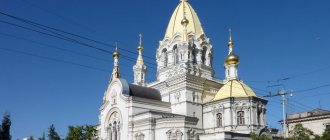| Penza Assumption Cathedral |
Penza Cathedral in honor of the Dormition of the Blessed Virgin Mary
, cathedral of the Penza diocese
- Altars: Dormition of the Blessed Virgin Mary (main), St. Alexy, Metropolitan of Moscow (left), Myrrh-Bearing Women (right); St. Seraphim of Sarov (lower church under the southern aisle)
- Address: Russia, Penza, st. Zakharova, 6.
- On the map: Yandex.Map, Google map
Construction of the temple began in 1895 at the Myronositsky cemetery in the city of Penza, south of the Myronositsky Church (burnt down in 1899).
In 1899, the Church of St. Sergius of Radonezh (destroyed in the 1930s) was consecrated in the tomb (apparently built under the bell tower). The construction of the temple was carried out using public donations and was completed in 1905. On May 1 of this year, the main altar was consecrated in honor of the Dormition of the Mother of God, on May 15 - the left one in the name of St. Alexis of Moscow, on June 19 - the right one in honor of the Myrrh-Bearing Women.
After the revolution (probably in 1922), the temple passed to the renovationists. In 1931 - 1937, there was a renovationist bishop's see here and, most likely, the Penza-Kazan miraculous icon of the Mother of God. In 1931 - 1933, before his first arrest, priest Alexander Petin, Nikon in monasticism, the future bishop, served here.
In 1937 [1] after the arrest of all the church servants, led by the Renovationist Archbishop Sergius (Serdobov), the church was closed. In subsequent years, it housed a military ski warehouse.
On April 6, 1945, the temple reopened to believers, and soon the bishop’s department was moved there from the Mitrofan Church [2].
From 1950 to 1953, iconostases were built in it.
In the 1970s, a lower church in the name of St. Seraphim of Sarov was built under the southern aisle for funeral services. Opposite the altar of the cathedral there is a grave in which Penza archbishops Theodosius (Pogorsky) (reburied here in August 1996) and Seraphim (Tikhonov) are buried.
There is a Sunday school at the cathedral, and since 1995 there have also been theological courses for the Penza diocese.
Story
Since 1663, the ancient city of Penza has risen on the banks of the Sura River. The Assumption Cathedral appeared a little later. Its construction was preceded by a small church built in 1836 on the territory of the Mironositsky cemetery. In 1899 it burned down, and the need arose to build a new temple. The church elders M. E. Ivanovsky, S. L. Tyurin, A. D. Gutorov and the rector, Archpriest G. N. Feliksov, took on the difficult task of arrangement. The new church was built with donations from parishioners.
The cathedral project was developed by the famous engineer A. G. Starzhinsky in 1895. Donations for the temple were collected by the whole world, the blessing for construction was received from the Holy Synod in 1901, and all of Penza was awaiting the opening. The Assumption Cathedral opened its doors in 1905. Three chapels were consecrated in the temple - the left one was consecrated in honor of Metropolitan Alexy of Moscow, the right one in honor of the Holy Myrrh-Bearing Women, the central altar is dedicated to the Dormition of the Virgin Mary. The sacrament of consecration was performed by the rector of the church, Bishop Tikhon.
Home › Temples and monasteries
Assumption Cathedral. Annunciation Church-Baptismal Church
In 1836, the stone Myronositsa Church was built in one of the city cemeteries, consecrated on October 18 of the same year.
The priest of the Spiritual Church, Simeon Alekseevich Karmilov, took care of the construction of the temple. In 1891, the chapel of Sergius of Radonezh was consecrated at the temple. Since 1875, a wooden chapel was assigned to the Myronositsa Church above the holy spring, next to the cemetery (by the beginning of the 20th century, the chapel no longer existed). In 1895, it was decided to build a new church, the Assumption Church, at the Mironositsky cemetery. On April 17, 1895, the construction department of the provincial government approved its project, which was developed by the architect Alexander Gavrilovich Starzhinsky (1850-1906), in 1883-1905. served as provincial engineer and head of the construction department. He created a wonderful monument of the Russian national style. Almost the same temple as the Assumption was built by him in the village of Bolshaya Luka, Kerensky district.
In 1895, construction of a new church began south of the Myronositsa Church. The rector, Archpriest Grigory Nikolaevich Feliksov, and the patrons, Maximilian Evlampievich Ivanovsky, Stepan Lavrentievich Tyurin and Alexey Dmitrievich Guttorov, showed great diligence during the construction. Soon, in 1899, the old church burned down. In the same year, the Church of St. Sergius of Radonezh (destroyed in the 30s) was consecrated in the tomb (apparently built under the bell tower).
In 1905, the Assumption Church was completed and consecrated by Bishop Tikhon. On May 1, the main altar was consecrated in the name of the Dormition of the Mother of God, on May 15 - the left one in the name of Alexy of Moscow, on June 19 - the right one in the name of the Myrrh-Bearing Women.
After the revolution (probably in 1922), the Assumption Cathedral passed to the Renovationists. In 1931-1937 here was the renovationist bishop's see and, most likely, the Penza-Kazan miraculous icon of the Mother of God. In 1931-1933, before his first arrest, priest Alexander Petin, a monk Nikon (1902-1956), served here. In 1944 he became Bishop of Voroshilovgrad and Donetsk, in 1948 - of Odessa and Kherson, in 1951 - Archbishop. In Odessa he is still revered as an outstanding archpastor.
In 1937, after the arrest of all the church servants led by Archbishop Sergius (Serdobov), the Assumption Cathedral was closed. In subsequent years, it housed a military ski warehouse.
On April 6, 1945, the cathedral reopened to believers, and soon the bishop's department was moved there from the Mitrofan Church. At the end of the 70s. In the cathedral, a lower chapel was built in the name of Seraphim of Sarov - mainly for performing funeral services.
In 1970-1975 the rector of the cathedral was Archimandrite Yuvenaly (Tarasov), now retired schema-metropolitan of Kursk and Rylsk; in 1988-1991 – Archimandrite Barsanuphius (Sudakov), now Metropolitan of St. Petersburg and Ladoga. Keymaster and priest of the cathedral in 1997-2001. Served as Hieromonk Seraphim (Domnin), now Metropolitan of Penza and Nizhnelomovsk.
Since 1991, the rector of the church has been mitered Archpriest Sergius Loskutov, secretary of the diocesan administration. On October 2, 1999, the liturgy in the cathedral was celebrated by His Holiness Patriarch Alexy II. In 1988 and 1990 the services were twice led by His Eminence John (Snychev), the future Metropolitan of St. Petersburg and Ladoga; January 17, 2010 – His Eminence Hilarion (Alfeev), Archbishop (now Metropolitan) of Volokolamsk, Chairman of the Department for External Church Relations of the Moscow Patriarchate.
On October 22, 2000, the relics of St. Innocent of Penza (1784-1819) - one of the main shrines of the diocese - were transferred to the Assumption Cathedral.
Behind the altar of the cathedral are the graves of Archbishops Theodosius (reburied here in August 1996) and Seraphim (who died on July 3, 2000). Artists K. A. Makarov (1862) and V. V. Galaktionov (1897), architect A. G. Starzhinsky (1906), director L. S. Samborskaya (1955), musician N. A. Vitver were buried at the Mironositsky cemetery (1959) and many other famous Penza residents.
In 1990-1994. next to the cathedral - almost on the site of the former Myronositsa Church - the Annunciation Church-baptism was built. The project was developed by the Penza architect Dmitry Aleksandrovich Borunov, the paintings were carried out by the Syzran artist Sergei Saksonov. The consecration of the temple took place on December 10, 1994. In the early 2000s. The baptismal church was completely painted.
On February 22, 2015, a memorial museum of Archbishop Seraphim of Penza and Kuznetsk (Tikhonov, 1935-2000) was opened at the cathedral.
Address: st. Zakharova, 6 Phone Website: uspsobor.ru
Rector: Archpriest Sergiy Loskutov Keynote: Priest Sergiy Chervyakov
Patronal feasts: August 28 - Assumption of the Blessed Virgin Mary 2nd Sunday after Easter - Sts. Myrrh-Bearing Woman February 25, June 2 – St. Alexy of Moscow January 15, August 1 – St. Seraphim of Sarov April 7 – Annunciation of the Blessed Virgin Mary
Shrines: Relics of St. Innocent of Penza; reliquary with a particle of the relics of St. Pimen Ugreshsky; Spanish icons John Olenevsky and Blessed. Matrona of Moscow with particles of relics; ancient revered icons of the Mother of God - Kazan, Iveron, Mammal; icons of the Savior, St. Nicholas the Wonderworker, St. Sergius of Radonezh, martyr. Panteleimon.
Schedule of services: On weekdays, liturgies are celebrated at 8.00, evening services - at 17.00 in the summer, and at 16.00 in the winter (from the Intercession to the Annunciation). On Sundays and holidays, liturgies are celebrated at 7.00 and 9.30. On Saturdays and on the eve of holidays, all-night vigils are always held at 17.00. The temple is open daily from 7.00 (on Sundays and holidays from 6.00) until the end of the evening service. In the Annunciation Church, only the sacrament of baptism is regularly performed.
Educational activities: Since 1995, the cathedral has offered four-year theological courses for people with higher secular education. Classes are held on Sunday, Monday, Tuesday and Wednesday evenings. Since the beginning of the 90s. There is a Sunday school for children 7-13 years old. Classes are held on Sundays at 12.00. In 2012, four-month catechetical courses began for those wishing to learn more about Orthodoxy. There is an Orthodox library at the cathedral. On Fridays at 18.00 and on Saturdays at 14.00, conversations are held for those wishing to receive the sacraments of baptism or wedding. Since November 2010, there has been a youth group “Sretenie” at the cathedral. Its participants meet on Sundays at 18.00. In their care are several elderly parishioners.
Social service: Since 1999, the cathedral has had a sisterhood named after. M. M. Kiseleva. It takes care of the Kuznetsk orphanage. When children are sent for treatment to inpatient medical institutions in Penza, nurses provide all the necessary care for them. Since 2004, a charity canteen has been operating at the cathedral, which provides hot meals to up to 50 people in need on Saturdays and Sundays from 11.00 to 13.00. Since February 2010, the cathedral has had a social worker. On Easter and Christmas for the pupils of the social orphanage on the street. Litvinov and correctional classes at school No. 30 on the street. Patsayev hosts holidays; on the Assumption and the day of remembrance of St. Innocent at the cathedral they organize a field kitchen for parishioners; pilgrimage trips are organized for the poor; a social worker makes home visits to former diocese employees and cathedral clergy. The Union of Orthodox Women, created in 2010, is also located at the cathedral. Its members meet in the library on Sundays at 12.00.
— Shortened link: https://eparkhiya.ru/?p=2917
From the revolution to the present day
Approximately in 1922, the Assumption Cathedral (Penza) was transferred by the Soviet authorities into the hands of priests of a new formation - to conduct services for the Renovationists. From 1931 to 1937, the cathedral housed the episcopal department of the Renovationists and probably housed the revered Penza-Kazan miraculous icon of the Mother of God.
The Renovationist priests were arrested in 1937, and the cathedral was closed. For some time it housed army ski warehouses. Only after 1945 services began to be held in the temple. Penza was revived along with the temple. The Assumption Cathedral became the bishop's see. At the end of the 70s, the lower chapel was equipped for funeral services, consecrated in honor of Seraphim of Sarov.
History of the temple
Penza was founded in the middle of the 17th century. The Assumption Cathedral was built much later. Before it was built, on this site - the Mironositsky cemetery - there was a small church consecrated in honor of St. Women of the Myrrh-Bearers. Unfortunately, it was completely destroyed by fire, which often happened to wooden buildings in that period. After this, the question arose about the need to build a new temple in an empty clearing.
Assumption Cathedral in Penza
The authorship of the project for the future cathedral belonged to engineer Starzhinsky. Funds for construction were donated by parishioners. In 1905, the new majestic cathedral opened its doors to the Orthodox. The whole city was looking forward to this event. Three altars were built and consecrated in the cathedral:
- Dormition of the Blessed Virgin Mary;
- St. Myrrh-Bearing Women;
- Metropolitan Alexy Moskovsky.
After the revolution in 1922, the Soviet government handed over the building to the renovationists to carry out their services. In 1931-1937 within the walls of the cathedral the cathedral of the bishop of the Renovationists was located. It is assumed that during the same period the miraculous Penza-Kazan icon of the Blessed Virgin Mary was kept there.
In 1937, the renovationists were arrested and the temple was locked. Some time later, a warehouse was organized there where army skis were stored. After the end of the Second World War, the temple was opened and services began to be held there. Having spiritual support, the whole city began to revive. The bishop's pulpit was placed within the walls of the temple. At the end of the 70s, a lower chapel was created, which was consecrated in honor of St. Seraphim of Sarov.
Modernity
In 1996, an administrative building was built next to the church, where premises for Sunday school, the rector’s office, a conference room, a dormitory, etc. are located.
In 2000, one of the main shrines of the city - the relics of Innocent of Penza - was moved to the Assumption Cathedral (Penza). In 1994, the baptismal Annunciation Church opened next to the Assumption Cathedral, and its consecration took place in the same year. In 2015, a museum dedicated to the memory of Archbishop Seraphim of Kuznetsk and Penza was opened at the cathedral.
Schedule of services and shrines
The main shrine of the Assumption Cathedral - the relics of St. Innocent of Smirnov-Penza, has been in the temple since October 22, 2000.
Also buried behind the altar of the temple are Archbishops Theodosius and Seraphim.
Divine service in the Church of the Assumption of the Blessed Virgin Mary
In the Assumption Cathedral, Liturgy is celebrated daily at 08:00, on Sundays and holidays - two Liturgies: early - at 07:00, late at 10:00. At the end of the liturgy, a memorial service and prayer service are performed.
Prayers are served daily at the relics of St. Innocent, and an akathist is read before the evening service.
On Wednesday, during the evening service, akathists are read: to St. Nicholas the Wonderworker, St. Seraphim of Sarov, and the Holy Great Martyr Panteleimon - alternately.
Architecture
The cross-domed five-domed Assumption Cathedral (Penza) rises on the top of the hill, rising from the ground and rushing upward with domes. As you approach the temple, its monumentality and the thickness of the walls become obvious. In plan, the structure has a rectangular outline.
The church is surrounded on three sides by porches marking the entrances to the premises. The two-height temple is crowned with a central drum; on each dome there are gilded crosses with which Penza is consecrated. The Assumption Cathedral inherited the best traditions of ancient Russian architecture. The author of the project managed to avoid an excessive amount of detail in decorating the facades.
The complex lacks a bell tower; it was replaced by a small belfry located above the western wing. The central entrance to the cathedral is decorated with two icons - the Resurrection of Christ and the Myrrh-Bearing Women. In the eastern part of the temple there are three semicircular apses - according to the number of consecrated altars. On the facade of the apses, in the niches, there are icons, thanks to which, without even entering the temple, you can find out in whose honor they were consecrated.
Sunday School
The Assumption Cathedral (Penza) leads an active social and educational life. Several institutions operate for the church community and everyone who wants it. Sunday school is open for the little ones. For more than 20 years, she has been helping children understand the world from the perspective of the Orthodox faith. The school was consecrated in honor of St. Innocent of Penza.
Training is conducted at four levels, corresponding to the age groups of children:
- From 3 to 6 years. Most of the classes are devoted to creativity - modeling, drawing, games, singing and other developmental lessons. Children spend up to 1.5 hours at school, accompanied by adults, and the beginning and end of classes are concluded with a short prayer.
- From 7 to 9 years. The duration of lessons is up to 3 hours, classes are attended independently. Children take part in performances, organize general events, and receive small tasks.
- From 9 to 12 years. For children of this age, the first theoretical classes are introduced - the Law of God, the study of the Church Slavonic language, singing. Some of the students begin to take part in choral singing in the choir along with adults. Children's liturgies are accompanied only by Sunday school students. Creative classes are open to everyone, the basics of icon painting are taught.
- From 13 to 15 years old. A new subject is added to the traditional lessons - the history of the church from ancient times to the history of the new martyrs of the 20th century. Students take part as voluntary assistants in charity events and bishop's services. Boys, if desired, help the priests at the altar.
The emphasis in raising children is on cultivating internal morality, churching and broadening their horizons.
Youth Society
The city of Penza is proud of its people and history. The Assumption Cathedral takes an active part in the education of young people. There is an Orthodox youth society at the parish. Participants provide assistance to those in need, conduct educational activities and simply communicate.
Activities:
- Social work includes visiting shelters, orphanages and social homes for the elderly. Much time is devoted to caring for the sick, infirm, elderly, and disabled. The parish often organizes charity fairs, events, concerts and other events, where the youth wing acts as organizers, participants, and volunteers.
- Missionary work. The range of activities includes trips to schools with stories about Orthodoxy, conversations with the priest, joint reading, discussion of the Gospel and other spiritual literature. On holidays, young people distribute booklets to attract parishioners to the temple.
- Difficult mission. As part of their activities, society members provide assistance to the parish, make trips to monasteries, churches in Penza and the region.
Cultural, historical, spiritual heritage
The Assumption Cathedral (Penza) is located at the ancient Mironositsky cemetery. When they were founded, these objects were located outside the city, and now they are part of the center of the city’s infrastructure. The graveyard was intended for the burial of the inhabitants of Penza, but historically it became the last refuge for the majority of Penza merchants. The surviving tombstones reflect the ancient traditions of burial design; there are memorials in the form of lecterns, urns, and vases with images of cherubs. Several tomb chapels attract attention.
The Assumption Cathedral and eight objects of the Mironositsky cemetery are the cultural heritage of the Russian Federation. List of protected cultural heritage:
- Assumption Cathedral with interior.
- Individual burials - S. M. Zhuravleva (Hero of the Soviet Union, participant in two wars), A. A. Igosheva (Hero of the Soviet Union, participant in two wars), L. M. Samborskaya (Honored Worker of Culture of the RSFSR, director, actress), I. V. Gribova (Russian and Soviet scientist, professor, leading specialist in the field of internal combustion engines), N. M. Savkova (doctor of medicine, outstanding surgeon and public figure), N. A. Shchepetilnikova (doctor, public figure).
- Mass graves of soldiers who died from wounds in Penza hospitals during the war. In total, 648 soldiers found peace at the Mironositsky cemetery.
The graves are cared for by volunteers, public organizations and the Orthodox community of the Assumption Cathedral.
Services and patronal holidays
Patronal feasts, especially revered in the cathedral:
- Dormition of the Blessed Virgin Mary (August 28).
- Holy Myrrh-Bearing Women (second Sunday of Easter).
- Saint Alexy of Moscow (February 25 and June 2).
- Venerable Seraphim of Sarov (January 15 and August 1).
- Annunciation of the Blessed Virgin Mary (April 7).
How does the Assumption Cathedral (Penza) work? Standard service schedule:
- Weekdays: 08:00 – liturgy, evening service – 17:00 (from the Feast of the Intercession to the Day of the Annunciation, the evening service begins at 16:00).
- Holiday and Sunday liturgies begin at 07:00 and 09:30.
- Saturday and holiday all-night vigils begin at 17:00.
The temple is open daily from 07:00, seven days a week, and closes at the end of the evening service. The church is a tourist attraction; many townspeople and guests strive to get to the ancient Assumption Cathedral (the schedule of services is given above). Information can be obtained by contacting the phone number listed on the official website.
Modern activities
After reconstruction in 1996, an additional administrative building was built near the temple. It houses a dormitory, the rector’s workroom, a Sunday school, etc.
The relics of St. are kept within the walls of the temple. Innocent of Penza.
Sunday School
Large-scale educational activities are carried out on the basis of the cathedral. Currently, several institutions are operating at once. For more than 20 years, classes have been held at the Sunday school, which was consecrated in honor of St. Innocent of Penza. School students are divided into classes by age:
- 3–6 years. Classes are held in the presence of parents. Most of the time is devoted to creativity. Children are given about 1.5 hours per lesson.
- 7–9 years old. The lesson lasts up to three hours. Students take part in various productions and organize joint events. They are assigned simple tasks.
- 9–12 years old. From this age, children are introduced to the Law of God, classes are held in the Church Slavonic language and singing. Some of the students get the opportunity to take part in the service in the choir. Children's liturgies in the cathedral are held only for students of this school.
- 13-15 years old. In addition to standard school lessons, children study the history of the church, which covers the entire period from the first Christians to the new martyrs of the 20th century. Students assist in charity events. Boys may, if they wish, assist the priests during services.
Morality is brought up in children. The classes allow them to broaden their horizons and join the Church.
Interior decoration and iconostasis
Youth Society
The youth society created on the basis of the cathedral operates in several directions:
- Social work. Participants provide assistance to lonely, sick, and elderly people, visit orphanages, and organize charity events.
- Missionary work. This includes visiting schools and holding conversations with children, distributing literature.
- Cooperation. Participants help the cathedral and visit monasteries and other churches for this purpose.
Cultural, historical, spiritual heritage
When the cathedral was built on the cemetery grounds, this place was the outskirts of the city. But Penza has grown, and now the cemetery and temple are in its center. The graveyard was intended for ordinary people, but the remains of many major merchants of the city are buried here. Ancient tombstones made in the old traditions, urns, and tomb chapels stand out.
The list of cultural heritage sites of the Russian Federation includes the cathedral itself and eight other buildings located in the cemetery. There are also mass graves of soldiers who could not be saved in city hospitals during the Second World War. The care of the graves is carried out by the parish of the temple, volunteers and public organizations.
The relics of St. Innocent are the main shrine of the monastery
Services and patronal holidays
Several altars are consecrated in the cathedral. Therefore, patronal feasts are celebrated here several times a year:
- Assumption of the Blessed Virgin Mary - August 28;
- Holy Myrrh-Bearing Women - second Sunday after Easter;
- St. Alexy Moskovsky - February 25, June 2;
- St. Seraphim of Sarov - January 15, August 1;
- Annunciation of the Blessed Virgin Mary - April 7.
Each patronal feast is a special event in the life of the church. It is accompanied by a solemn service. On this day, not only parishioners, but also many guests and pilgrims from other cities rush to visit the temple.
